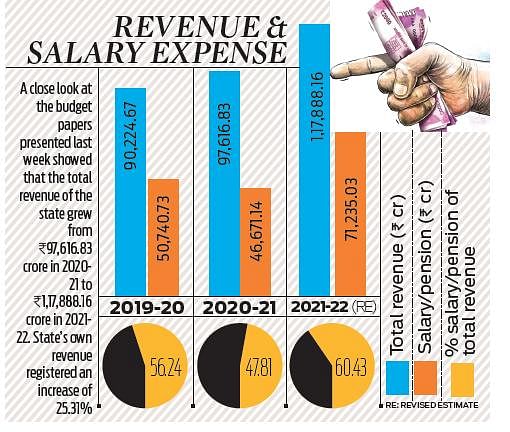
THIRUVANANTHAPURAM: There is heartening news for Kerala’s economy. The dark predictions about an imminent economic collapse made by incorrigible Government-baiters and doubting Thomases have been proved to be what they are: patent falsehoods.
The facts speak for themselves. The data are self-explanatory. The news that makes delightful reading is that Kerala’s tax revenue has recorded a robust growth. The fiscal year 2022-23 shows a remarkable growth rate of 22.11 per cent in 2022-23 compared to 2021-22. The State’s own tax revenue has perked up in a big way. Kerala is second only to Maharashtra (25.6%) and Gujarat (28.4%). These two states have been able to produce better results because they boast strong manufacturing bases. Compared to this, Kerala’s feat is no less impressive despite it being a big consumption state.
The remarkable rise in Kerala’s own tax revenue is being ascribed mainly to the Goods and Services Tax (GST). Experts say GST collections are showing a steady improvement. The GST collections grew by 19.44 per cent to Rs 34,641 crore in 2022-23. The State’s own tax revenue has gone up to Rs 77,164.84 crore from Rs 63,191.75 crore posting an increase of nearly 14,000 crore.
The problems plaguing the State’s economy are due primarily to the “faulty fiscal policies” of the Union Government towards the States in general and Kerala in particular. Just to cite an instance, the State’s share of grants in aid from the Centre suffered the highest decline from 25.8 per cent to 20.6 per cent, representing a 5.2 percentage points. In the case of Kerala, the share of central taxes fell from 11.13 per cent to 9.38 per cent.
As for revenue mobilization, the highest growth was witnessed in land revenue because of the increase in rates. Revenue from land transactions saw a 52.95 per cent rise from Rs 470.81 crore to Rs 720.10 crore. Excise duties of the State posted a 41.52 per cent growth to Rs 2,875.95 crore in 2022-23 from Rs 2,032.23 crore. Last year also saw a marked decline in borrowing as well – -47 per cent. This is being attributed to severe curbs on borrowing in Kerala in the name of off-budget borrowing.
Kerala also recorded a big decline in revenue expenditure – -2.63 per cent. The all-India average for revenue expenditure growth was 11.5 per cent. This is an impressive achievement viewed against the highest revenue expenditure growth recorded by states like Andhra Pradesh (26.1 per cent), Punjab (17 per cent), Maharashtra (16.1 per cent) and Odisha (16.1 per cent).
The habitual Kerala critics ended up with egg on their faces because the Fitch Ratings has reversed the outlook on Kerala to “stable” from “negative”, while retaining the ‘BB’ rating for the state’s long-term foreign and local currency issuer default ratings (IDR). The revised ratings are reflective of the improving trend in the wake of the pandemic. The state’s economic expansion will effectively undo the increased debt burden, leading to steady debt ratios. The remarkable turnaround has come in less than 10 months. It may be mentioned that the rating agency had revised the outlo9ok of the State in October last year to negative from stable while keeping the BB rating.
Welcoming revision from negative to stable, Kerala’s finance minister K N Balagopal asked the opposition parties to fight for the State’s rightful share from the central pool of taxes and stop blaming the LDF Government for the state’s financial problems.
Meanwhile, in an interesting development, economic experts have come up with a novel suggestion to counter the decline in the State’s share from the divisive pool of central taxes. The prescription is this: Kerala should allow the number of migrant workers in the State to be counted as its population in the next census! The best way to do this is to encourage the migrant workers to settle in the State with their families. That way they will be included in the population count. The result will be a larger share from the central government’s divisive pool.
At present, Kerala’s share from the central divisive pool has come down from 3.875 per cent in the 10th Finance Commission to 1.925 per cent in the 15th Finance Commission. The fall in the divisive pool for Kerala is because over 60 per cent of the weightage for such devolution is linked to population. Kerala’s population growth, at present, is less than 1 per cent annually, while north Indian states like Bihar, Madhya Pradesh Rajasthan and Uttar Pradesh are growing at nearly 2 per cent per annum. This results in greater share for them in divisive pool.
A survey conducted in 2013 had estimated Kerala’s migrant population at close to 25 lakh. It could well be anything between 50 and 60 lakh now. It is also estimated that the migrants send nearly 25,000 crore back to their home states annually.
Kerala also prides itself on providing a slew of benefits to migrant workers. It is the first state to enact a social security scheme for them. (IPA Service)
The post 22 Per Cent Growth In Kerala’s Tax Revenue first appeared on Latest India news, analysis and reports on IPA Newspack.


